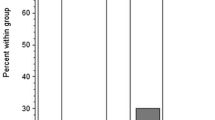Summary
A technique is described for studying the effects of drugs with anticholinergic properties on human forearm sweat glands. The response of sweat glands to intradermal injections of increasing concentrations of acetylcholine (ACh) in saline was measured. The number of glands activated was recorded by painting the injection area with a plastic impression paint one minute after injection. The plastic impression was removed using “Sellotape”, mounted on a 35 mm slide, projected, and glands counted. Standardisation of conditions was important with respect to ambient temperature and physical activity of subject in order to reduce spontaneous sweat gland activity. The dose response relationship was similar for men and women. In a double blind, controlled, cross over investigation, 8 subjects (4M and 4 F) received lactose dummy and atropine sulphate 1 mg p. o. Sweat gland activity, salivation, heart rate, pupil size and visual near point were measured before and 1 and 2 h after treatment. Significant (P<0.05) reduction occurred in the number of glands responding to 140 and 550 µM ACh and also in the salivary secretion rate 2 h after atropine, compared with values after lactose dummy. No significant changes in pupil size, visual near point or heart rate occurred. It is suggested that inhibition of the response of forearm sweat glands to ACh is at least as sensitive as other measures of parasympathetic functions for assessing parasympatholytic agents.
Similar content being viewed by others
References
Allen, J. A., Roddie, I. C.: The role of circulating catecholamines in sweat production in man. J. Physiol.227, 801–814 (1962)
Benjamin, F. B.: Sweating response to local heat application. J. Appl. Physiol.5, 594–598 (1953)
Chalmers, T. M.: Effects of autonomic drugs on sweat secretion in man. M. D. Thesis, University of Edinburgh 1950
Chalmers, T. M., Keele, C. A.: Physiological significance of the sweat response to adrenaline in man. J. Physiol.114, 510–514 (1951)
Chalmers, T. M., Keele, C. A.: The nervous and chemical control of sweating. Br. J. Dermatol.64, 43–54 (1952)
Christie, M. J., Venables, P. H.: Site, state and subject characteristics of palmar skin potentials. Psychophysiology9, 645–649 (1972)
Collins, K. J., Sargent, F., Weiner, J. S.: Excitation and depression of eccrine sweat glands by acetylcholine, acetyl-beta-methylcholine and adrenaline. J. Physiol.148, 592–614 (1959)
Coon, J. M., Rothman, S.: The sweat responses to drugs with nicotine-like action. J. Pharmacol.73, 1–11 (1941)
Craig, F. N.: Effects of atropine, work and heat on heart rate and sweat production in man. J. Appl. Physiol.4, 826–833 (1952)
Foster, K. G.: Analysis of sweat gland responses to intradermal injections of acetylcholine. J. Physiol.205, 11–12 (1969)
Foster, K. G., Weiner, J. S.: Effects of cholinergic and adrenergic blocking agents on the activity of the eccrine sweat glands. J. Physiol.210, 883–895 (1970)
Gibinski, K., Giec, L., Zmudzinski, J., Maclawczyk, J., Dosiak, J.: Body side related asymmetry in sweat gland function. J. Invest. Dermatol.57, 190–192 (1971)
Goodall, McC.: Innervation and inhibition of eccrine and apocrine sweating in man. J. Clin. Pharmacol.10, 235–246 (1970)
Haimovici, H.: Evidence for adrenergic sweating in man. J. Appl. Physiol.2, 512–521 (1950)
Herxheimer, A.: A comparison of some atropine-like drugs in man, with particular reference to their endorgan specificity. Br. J. Pharmacol.13, 184–192 (1958)
Janowitz, H. D., Grossman, M. I.: The response of sweat glands to some locally acting agents in human subjects. J. Invest. Dermatol.14, 453–458 (1952)
Kral, J. A., Zenisek, A., Kopecka, J.: Crossed locomotor and sudomotor innervation. Int. Z. Angew. Physiol.27, 165–170 (1969)
Lader, M. H.: Physiological measures in psychiatry. Sci. Basis Med.1975, 279–304
Randall, W. C.: Quantitation and regional distribution of sweat glands in man. J. Clin. Invest.25, 761–767 (1946)
Randall, W. C., Kimura, K. K.: The pharmacology of sweating. Pharmacol. Rev.7, 365–397 (1955)
Rodman, M.J.: The anhidrotic action of atropine on human thermoregulatory sweating. J. Am. Pharm. (Scient. Ed.),41, 484–487 (1952)
Shelley, W. B., Horvarth, P. N.: Experimental malaria in man. J. Invest. Dermatol.14, 9–20 (1950)
Silverman, J. J., Powell, V. E.: A simple technique for outlining the sweat pattern. War Med.7, 178 (1945)
Thomson, M. L., Sutarman: The identification and enumeration of active sweat glands in man from plastic impressions of the skin. Trans. R. Soc. Trop. Med. Hyg.47, 412–417 (1953)
Author information
Authors and Affiliations
Rights and permissions
About this article
Cite this article
Clubley, M., Bye, C.E., Henson, T. et al. A technique for studying the effects of drugs on human sweat gland activity. Eur J Clin Pharmacol 14, 221–226 (1978). https://doi.org/10.1007/BF02089963
Received:
Revised:
Accepted:
Issue Date:
DOI: https://doi.org/10.1007/BF02089963




